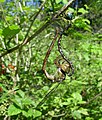Aeshnidae
| Aeshnidae | ||
|---|---|---|
 | ||
| Taxonomía | ||
| Reino: | Animalia | |
| Filo: | Arthropoda | |
| Clase: | Insecta | |
| Orden: | Odonata | |
| Familia: |
Aeshnidae Rambur, 1842 | |
| Géneros | ||
| ||
Los ésnidos (Aeshnidae) son una familia odonatos anisópteros.
Incluye las libélulas más grandes de Europa y Norteamérica, que a su vez están entre las más grandes y más veloces del mundo, en especial los miembros de los géneros Aeshna y Anax; la especie africana Anax tristis tiene una envergadura de más de 125 mm, y es una de las libélulas más grandes del mundo. Hay 41 especies norteamericanas en 11 géneros incluidos en esta familia.
La mayoría de las especies europeas pertenecen a la familia Aeshnidae. Se han realizado propuestas para separar la familia en Aeshnidae y Telephlebiidae (Hawking & Theischinger, 1999).[cita requerida]
Características
[editar]Los adultos tienen cuatro grandes y delicadas pero potentes alas que les permiten volar durante mucho tiempo sin agotarse. Sus alas están siempre extendidas horizontalmente, y les permiten volar en cualquier dirección. Su abdomen es largo y delgado, en la mayoría de los casos de color verde o azul, con manchas ocasionalmente amarillas o negras. Tienen ojos compuestos hemisféricos de gran tamaño, que les permiten una excelente visión. Son voraces predadores que usan las partes afiladas de su boca para cazar y alimentarse.
Historia natural
[editar]Las libélulas se aparean durante el vuelo, y depositan los huevos en el agua o cerca de ella. Se alimentan de otros insectos o incluso pequeños peces.
Son extremadamente difíciles de capturar debido a su gran velocidad y manejo en el vuelo y a su excelente visión.
Galería de imágenes
[editar]-
Adversaeschna brevistyla
-
Aeshna cyanea (macho joven)
-
Anax imperator
-
Austroaeschna unicornis
-
Brachytron pratense (macho)
-
Coryphaeschna viriditas
-
Dendroaeschna conspersa
-
Epiaeschna heros
-
Gynacantha bayadera
-
Hemianax papuensis
-
Pinheyschna subpupillata
-
Rhionaeschna multicolor
-
Triacanthagyna trifida
Referencias
[editar]Silsby, J. 2001. Dragonflies of the World. Smithsonian Institution Press, Washington D.C.
Enlaces externos
[editar]Text is available under the CC BY-SA 4.0 license; additional terms may apply.
Images, videos and audio are available under their respective licenses.













